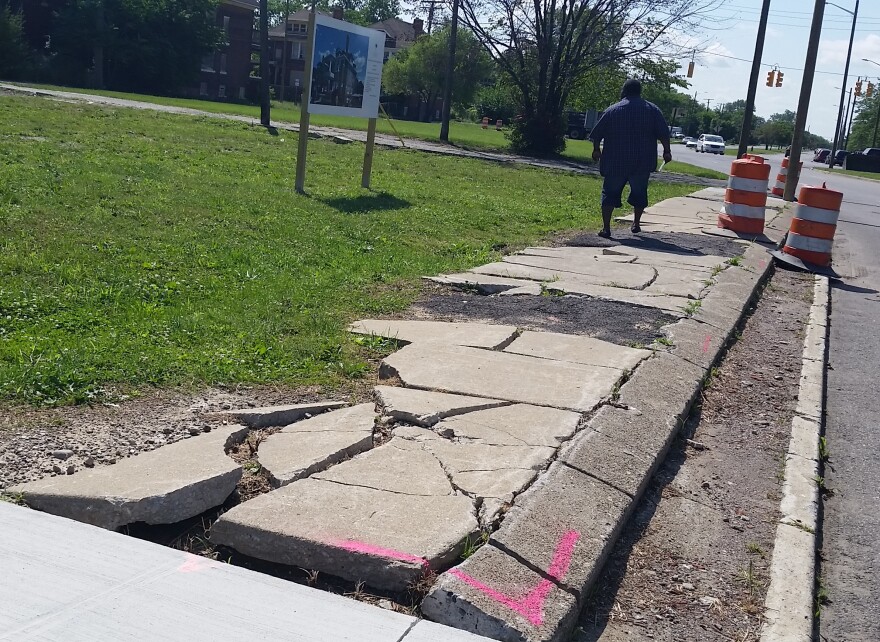This story originally aired on WKAR in July 2017.
In the early 1960’s, Detroit had one of the highest standards of living in the country.
But not everyone shared in the wealth.
In 1967, Detroit’s undercurrent of unrest burst to the surface. The riot that began on July 23 was the start of the worst civil disturbance in American history.
On a bright blue Detroit morning, a bold red helicopter pierces the neighborhood reverie.
“Is that the news?” Denise Gray asks, looking skyward.
She watches from the corner of Taylor and Woodrow Wilson in the city’s Virginia Park district. As cameras capture a peaceful scene, her mind’s eye conjures the memory of a much darker day.
“Smoke,” she recalls. “Nothing but smoke.”

Gray was just a little girl during those five violent days in the Summer of Love. In 1967, Detroit blazed outside her door two blocks off Woodward Avenue.
“You heard a lot of shouting,” Gray says. “You saw people just running and running and using profanity, just totally upset. It was very shocking. My aunt lived about a block from 12th and I was on the phone with her, and she just described a picture of horror.”
When the smoke cleared out, the scars set in.
Today, Virginia Park is a ghost of its old glory. The bustling shops that lined 12th Street, re-born as Rosa Parks Boulevard, are gone.

Many hopes are in disrepair. In spots, waist-high weeds burst through broken sidewalks.
“Three, five years ago; maybe 10 years ago, it was more dense, more populated, more people,” says George Adams Jr. He’s president of the West Euclid-West Philadelphia Street Neighborhood Association. “There were a lot of people who were active in the area. From then to now...it’s despair.”
Adams blames this blight on the foreclosure crisis that struck Detroit in the last decade. It’s still a big problem. But Adams is looking to some new projects that could jump start this part of the Motor City.
A private developer wants to refurbish the shuttered Herman Kiefer Hospital. In June, the Henry Ford Hospital on West Grand broke ground on a new cancer center. Across the street, the Motown Museum is planning its own $50 million expansion.
It all makes George Adams hungry for progress.
“So, we’re right in the middle,” he observes. “We have two pieces of wheat bread and I guess we’re going to be what we are. Are we going to be peanut butter and jelly, or are we going to be bologna and cheese or something like that. But eventually, it’s going to be a good sandwich.”
Detroit is eager to bite into the future. But it hasn’t forgotten the bad aftertaste of the past.
Work crews are laying fresh concrete at the northeast corner of Rosa Parks Boulevard and Clairmount. This is where the old Economy Printing building once stood, and the after-hours “blind pig” Detroit police raided on July 23, 1967. This is where the bottles, the bricks...and later, the bullets started flying.
This is Ground Zero.

The blind pig is no more. Today, Gordon Park stands in its place.
Revitalization is slowly taking hold in Virginia Park. Tony McDuffy, the deputy director of the neighborhood agency Central Detroit Christian, hopes the park will be an oasis for new families moving in, and a reminder that improvement has not come overnight.
“It’s people who’ve been here for 50 or 60 years who’ve said, ‘I’m not leaving Detroit,” McDuffy says. “I’m going to die here, I’m going to stay here.’ “
People like Denise Gray. She’s well aware how the story of 1967 affects her city. That’s why she wants to help write the next chapter now, in 2017.
“Sometimes when things are planted in a person’s mind, that’s exactly where it stays,” asserts Gray. “But I have a lot of confidence and that’s why I’m still here, and that’s why I have no intentions of moving.”
Reflections of...the way life still could be.



